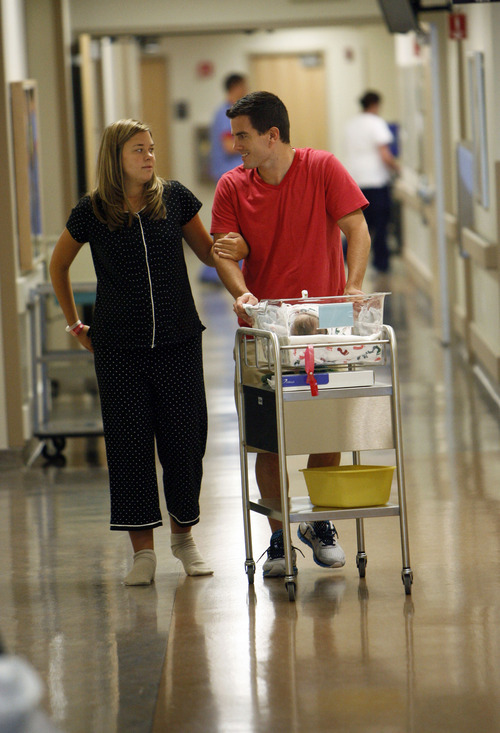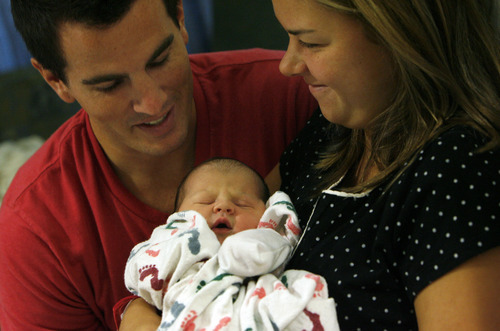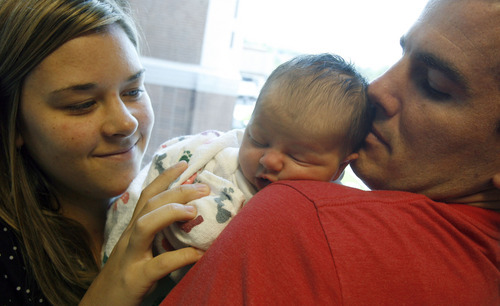This is an archived article that was published on sltrib.com in 2012, and information in the article may be outdated. It is provided only for personal research purposes and may not be reprinted.
The American Academy of Pediatrics says that the benefits of circumcising baby boys are greater than the risks, and insurance should cover the procedure.
The new announcement runs counter to the academy's advice in 1999, when it said circumcision had "potential medical benefits" but the data then available wasn't enough to endorse routine circumcision for male infants.
Whether the new recommendation will encourage more parents to choose circumcision remains unclear, but some doctors believe it will put pressure on states, such as Utah, that no longer pay for the procedure through Medicaid. Health Department officials in Utah are reviewing the policy in light of the new announcement.
"If they deny that to Medicaid patients, it seems to put the least well-off patients in the country at the highest risk for complications," said Pat Cartwright, a pediatric urologist and surgeon-in-chief at Primary Children's Medical Center.
The academy points to studies in Africa, where infection rates of HIV, human papillomavirus (HPV) and other diseases are lower in circumcised men. A review of studies shows that male circumcision reduces the risk of getting HIV for heterosexual males by 40 to 60 percent. One South African study found that high-risk HPV was found 32 percent less frequently in circumcised men.
Approximately 60 percent of U.S. newborn boys are circumcised, a number which has declined in recent years. The Western states have the lowest circumcision rate in the country, at 30 percent, compared to 74 percent in the Midwest.
In Utah, circumcision was declining even before the state Medicaid program stopped paying for the procedure in 2003. In 2000, almost 69 percent of newborn males were circumcised, a number that has continuously dropped. As of 2010, the most recent data available, 38.8 percent of newborn males were circumcised.
Tom and Ashlee Peterson, whose son, Carter, was born Tuesday at University Hospital in Salt Lake City, chose to have him circumcised after reading about related health issues. But the social implications made a particular impact.
"Being in the locker room when he gets a little older, it might be awkward if he's the only boy standing around who might be different," said Tom Peterson, who is a pharmacist. Most of the boys the Lehi family knows are circumcised.
After hearing about the new recommendation from the AAP, the father said he felt good about the decision. "When it comes down to it that's all that matters: This is what's best for our son," he said.
Culture and family tradition often dictate the decision, doctors report, even when insurance won't cover costs.
"Even when people have had Medicaid, family members will pitch in if they have to pay for a circumcision," said Dave Larson, the pediatrician at Heber Valley Pediatrics, where the procedure costs about $250.
He estimated that about 80 percent of the white and black infant boys he sees get circumcised, while only a small percentage of his Latino patients do. The procedure involves removing the foreskin, typically within the first few days or weeks after birth.
At Larson's office, a baby receives a shot of Lidocaine on each side of the penis and his legs are held down with a strap above the knee. With a blanket on his chest and a pacifier dipped in sugar water, the baby typically falls asleep.
But a growing number of American parents see the procedure as unnatural, unnecessary and in some cases akin to mutilation. This summer a German court ruled circumcision is equal to a criminal act, a decision that has led to a backlash by Jewish leaders for whom circumcision is a long-standing tradition.
Another study, recently published in the journal Archives of Pediatrics and Adolescent Medicine, highlighted the potential for declining circumcision rates to drive higher medical costs. The authors project that each year that male circumcision rates remain at 50 percent, $211 million more will be spent than if circumcision rates had stayed at 1980s levels.
They cite health issues that include HIV, herpes and urinary tract infections. One study at a Baltimore clinic that treats sexually transmitted diseases found circumcised men were 60 percent less likely to get HIV than uncircumcised men.
"The medical evidence of the benefits of male circumcision are abundantly clear," said Aaron Tobian, one of the paper's authors, and an assistant professor at Johns Hopkins University.
Making comparisons with Europe are difficult, he said, due to differences in the population and behaviors. Circumcision is nearly nonexistent in some Western countries, however. In the United Kingdom, only 15.8 percent of boys are circumcised, and in Denmark, only 1.6 percent are circumcised, the paper states.
Parents shouldn't discount the African studies, said Cartwright at Primary Children's.
"If you translate the African data and try to make sense of that on a U.S. population, I think that it is likely that some of that risk would be the same," he said.
But in Utah, where HIV infection rates are low, there may be some less apprehension of sexual disease.
"I'm not sure HIV is a big argument for people in Utah most of the time," said Charles Ralston, a pediatrician at Cottonwood Pediatrics who has seen the recommendation on circumcision change multiple times during his 30 years as a physician.
Ralston doesn't think the state's decision to stop covering circumcision was based on health factors.
"It had to do with money," he said. "I don't like a health care system that decides we're going to make decisions based on your socio-economic status."
Circumcision in Utah
The rate of circumcised male newborns has declined from 68.6 percent in 2000 to 38.8 percent in 2010.









